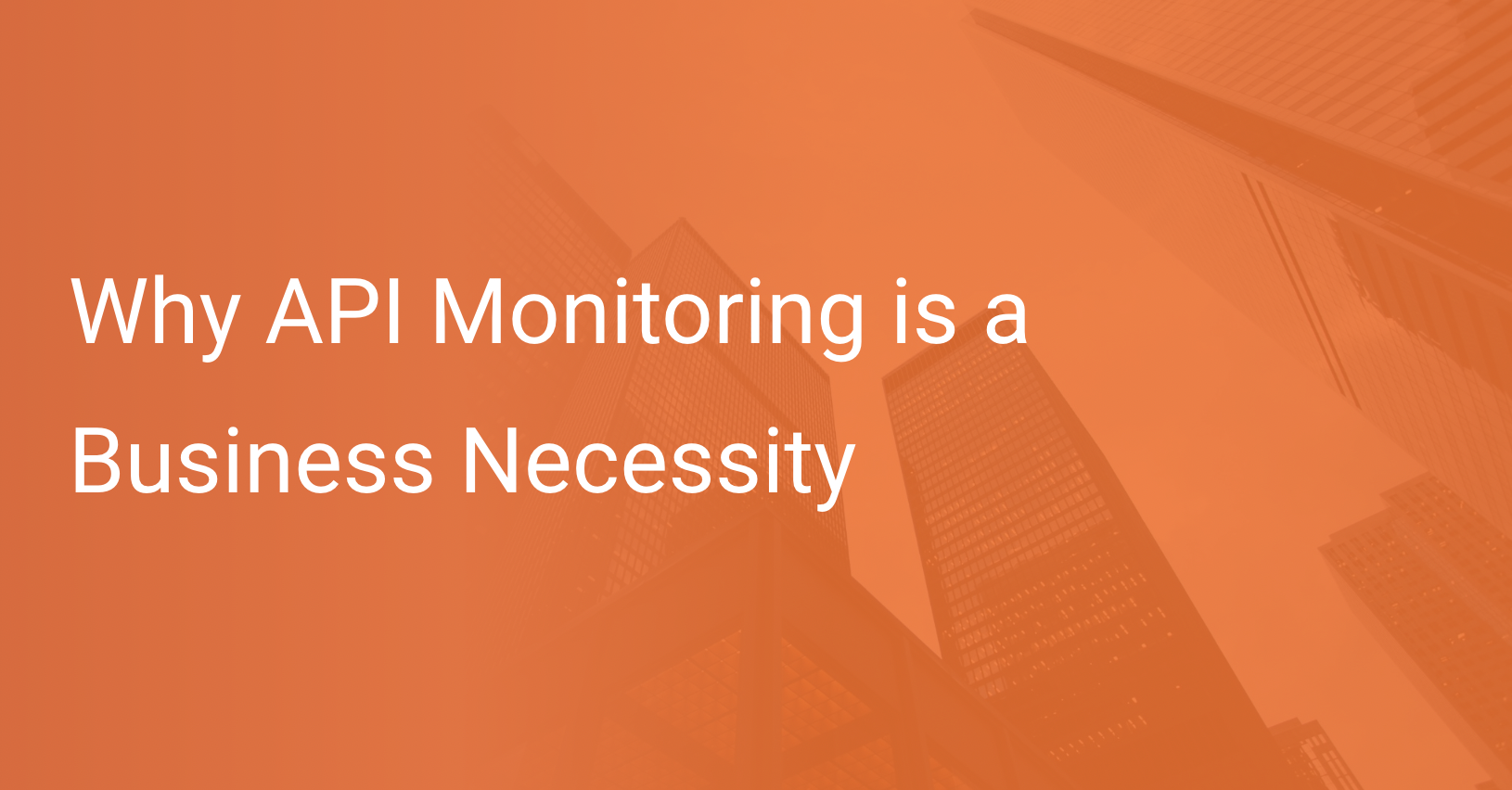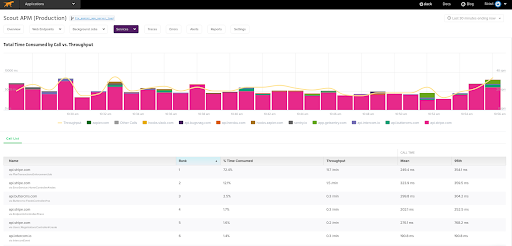Why API Monitoring is a Business Necessity

This article will discuss API Monitoring, the definition of APIs and how they would affect your business if there is a failure, and how to protect APIs or your services.
Everything on the web is powered by an API nowadays. APIs are an essential part of the web to connect different services that help customers complete their actions. This article will help you understand the importance of API and why API monitoring is a business necessity.
Here are some links to help you find your way around the guide:
- Why Invest in API Monitoring?
- How to Get Started with API Monitoring?
- Getting Started with API Monitoring
- Choosing an API Monitoring Tool
- Gain Visibility, Gain Peace of Mind
Why Invest in API Monitoring?
In a competitive business landscape, a downtime/crash in the application can cause millions of dollars lost in revenue. It can also badly affect customer retention and user experience for others. What’s even worse is that the technical team might not know what went wrong even though your application had monitoring set up. If your customers face errors/downtime repeatedly in you product, it can affect your brand’s reputation.
So, it’s crucial to monitor an application and the APIs of your application because APIs are the core of your business functionality. Providing a better user experience has become one of the deciding factors for business success.
Application Availability
When your website is up and running, users can see the content. But, if it fails when they click or make some action inside the application, it will create a bad experience if it’s not functional. For example, you might have configured website monitoring to monitor your application, and it did its job, but it couldn’t monitor the API failures. That’s where the problem comes in and creates a bad customer experience.
Also, your application might serve customers worldwide if it is functional in your region. It works when you test it, but when your customers from other regions/countries try to access your application, it fails. It can be hard to identify and resolve such issues unless your customers complain about them. One way of solving this problem would be to verify every time your team deploys a new feature. But, it is manual and time-consuming.
Another important thing is application availability during peak hours. Suppose you and your competitor are doing a flash sale, and your application crashes at peak hours. That can badly impact the customer experience, and the competitor can take over the deal during essential hours. In addition, it can affect the business revenue.
Performance Matters to Business
In the digital world, customers want to access and complete their tasks in a fraction of minutes or seconds on the web. Nowadays, people don’t want to wait for a website or application to load or any functionality. We believe that the faster the application, the better the experience. So, it becomes mandatory for any software application to load and work faster. It becomes a deciding factor for business success.
If your API is slow for some reason, it can directly impact the customer experience and business revenue. So, it’s essential to analyze the API performance and improve it.
Website Monitoring is Not Enough
Website monitoring allows monitoring of web applications to ensure that they are up and running correctly. It tracks the application with end-user experience and evaluates the availability from different regions. It also checks if the website and web application are accessible from different locations and cached based on the application configuration.
On the other hand, API Monitoring allows you to monitor your application API by sending requests to your API. It monitors API availability, response time, and performance. It also validates the response data from API.
Configuring website monitoring will not be sufficient to monitor applications in all aspects. For example, website monitoring will not monitor API if failure in API can impact the customer experience and usability.
Website monitoring is more of monitoring end-user experience, whereas API monitoring makes sure the services are up and running and APIs are working as expected.
Functionality
With the emergence of modern software development life cycles(SDLC) like Agile, teams design, develop, test, and deploy the application in an iterative process. So it’s important to maintain a monitoring process to provide a seamless experience to users. Otherwise, every time the team delivers a new feature, it can impact the customer experience if it’s not functional.
As we discussed, website monitoring is different from monitoring functionality. There are good chances that the application can crash or fail for some functionality, even if the application has website monitoring. So, it’s important to monitor API. Suppose it’s not functional when we deploy a new feature. Then, it can impact the business and the customers.
Integration Can Impact Business.
It’s difficult for any business to function in an isolated environment in today’s world. Users want to connect different applications from their daily usage to improve their lives, whether personal or professional.
On the other hand, It’s smarter for us to use the existing solution for the application instead of re-inventing the wheel. For example, let’s say that an application needs payment handling functionality. Instead of building it from scratch, we can leverage the existing payment handling solutions such as Stripe.
So integration has become an inevitable part of software development and businesses. But, it’s also important to note that the more integration we have, the more it’s prone to error. If the integration fails, it can potentially impact the application flow.
Customer Experience & User Satisfaction
Business solves users’ problems. So, a business must solve those problems with a flawless workflow, and only then does it solve the purpose. User experience and user satisfaction have become crucial deciding factors for a business. Building a business is hard, but managing a business with a high customer retention rate is harder.
So, it is important to avoid a bad customer experience. Common reasons for bad user experience in today’s business world are application flow, speed, availability, and functionality issues. We need to ensure that the application is up and running to maintain customer retention and a better user experience.
How to Get Started with API Monitoring
We discussed why it’s important to invest in API Monitoring. Now, let’s discuss what an API is and get started with API Monitoring.
What is an API?
API stands for Application Programming Interface. API is a big part of the web. But to explain it simply, it is an interface that enables two applications or services to exchange data.
API allows programs to interact with each other. Let’s say you’re in a restaurant ordering food. Here, a waiter will take orders and serve the food once it’s ready from the kitchen. Relating it to the API concepts, a waiter is an API here, and Order is the API call from client to server; food from the kitchen will be the response.
How API Monitoring Works
API Monitoring uses a remote system to send requests to the API. Based on the response from API, it evaluates API by the response time, response status, and content from API response. If an API fails first, the monitoring system will retry a few more times before sending an alert notification. Try a few more times because the monitoring system will ensure it’s not a false alert and the system is actually failing.
An application can have customers from around the world. So, the monitoring system will send requests to the API from different locations to make sure it’s available. For that, monitoring systems will use other agents to monitor API. If it also fails, the system sends an alert/notification about the specific failing service in the application.
Ways to Monitor APIs
There are different ways to monitor APIs. It can be simple monitoring or multi-step monitoring. Most complex applications need multi-step monitoring because complex systems always have integrations of external services. Let’s discuss the different ways to monitor API in detail.
Simple API Monitoring
It monitors APIs by sending requests to them and evaluating their response. It is a simple monitoring method to assess your API response time, content, and status. It mainly considers the availability of API or services.
Transactions Monitoring
It goes beyond evaluating API requests and responses. It checks API transactions and interactions between them. It’s a process of monitoring API by configuring consecutive API calls to monitor business transactions. In that way, it’s easy for us to monitor a business flow and evaluate its response time, values, and response statuses.
Getting Started with API Monitoring
When starting with API Monitoring, it’s important to consider important metrics. It helps to identify and fix the issues upfront before customers face them. API monitoring involves monitoring based on different categories.
Uptime Monitoring/Availability
It’s about monitoring the availability of your API. your application’s API can be from a public network or private network. An API from a public network doesn’t necessarily mean exposing API to users. Instead, it means that your client application using that API will be from a public network.
To monitor the availability of such an API, It should simulate real-time user scenarios as much as possible. For example, let’s say that your business has users from different locations worldwide. A monitoring system should simulate such a scenario by sending API requests from other regions. It should test if the monitoring system can not reach API from a specific region from multiple locations.
If an API is from a private network, there are agents and VPNs to access the API and test its availability. It’s important to note that the global distribution of testing agents is time-consuming if we use self-hosted solutions.
Performance Monitoring
Once we have evaluated the availability of API, we need to assess the performance of API to make sure that they are not slowing down the apps that consume them.
Sometimes, it’s not enough to monitor the availability and performance of a single API request and its response. For example, clients may consume aggregated views of data from API (or) consume data that may not be present in the cache layer. So, it is important to monitor the workflow to measure the API performance as workflow.
Another thing to note is where we monitor APIs from. First, it’s essential to monitor API from external systems. If the monitoring system sits inside the code (or) the same server, it can miss important factors to evaluate performance, such as DNS resolution, SSL validation, load balancing, and caching.
Data Validation
What if your API is fully available and fast enough but shows the wrong data to the users?. It is one of the common scenarios that customers face as an issue, and unfortunately, this scenario can create a bad user experience.
It’s essential to evaluate and inspect the data payload sent between client and server. Mostly, the data payload will be in JSON or XML. Therefore, to fully validate the payload, it is required to do JSON, XML parsing, data extraction, schema validation, evaluating dynamic variables, and multi-step monitoring.
Choosing an API Monitoring Tool
Now let’s take a look at some criteria and examples you should be aware of when choosing your next API monitoring tool.
Factors To Consider
Before choosing an API Monitoring tool, it is important to consider some factors. So let’s discuss such factors that can help make a better decision for the application and your team.
Usability
When monitoring APIs, you should consider the usability of the monitoring system as a primary factor. The easier to use, the more user-friendly it is. However, monitoring API involves testing an individual API, writing multiple request payloads, and repeating the process for several APIs. Managing all of those scenarios can be difficult if the tool is difficult to use.
Metrics & Dashboard
Metrics are a crucial part of analyzing and taking actions to monitor APIs. Because it makes it easy to identify the problem and take action, monitoring systems must capture metrics that help solve issues.
At the same time, it will increase the team's productivity and visibility if a monitoring tool gives an intuitive dashboard. So it’s another vital factor to consider while choosing a monitoring tool.
Security
We discussed monitoring your application APIs using monitoring systems. One of the common questions that come to our mind is how safe it is?. Because your application may handle sensitive data, you don’t want to expose it to unauthorized third parties. So you should consider security when choosing a monitoring tool since it’s crucial.
Integration
Integrating with existing systems is important for every business. For example, let’s say that your application can have website monitoring configured with your server and your team wants to integrate that data with an API monitoring tool. It is a common scenario that business applications face. Integration is a vital part of business application. So, make sure to analyze the monitoring tool in that aspect. It makes the team's effort simpler and avoids unnecessary complications popping up in the future.
Support
Let’s say your team configured a monitoring tool with your application but feels lost after some configuration steps. If there’s no proper support and documentation available, it will be challenging to process further, therefore affecting business productivity unnecessarily. Teams will spend time and effort resolving such situations rather than building business logic. So, it’s wise to choose a monitoring tool with better documentation and support.
Popular Choices
Here are some of the popular choices when it comes to API monitoring tools.
Scout
Scout monitors application performance by evaluating the errors, API endpoints, database operations, and external services. Scout’s agent connects with the application web services, assesses performance, tracks errors, and monitors third-party integrations.
It also provides monitoring performance of database operations and queries. Integration with scout is simple as we need to install the agent in the codebase.
Once configured, Scout monitors API endpoints, memory bloat in the web services, database queries, and external service integrations.
Here, we have API monitoring for external service integration. Scout monitors each external service integration’s response time and performance in detail.
Scout provides deep tracing logic that shows you the response time distribution. So, you can easily identify specific slow request outliers against average. It’s also simpler to identify slow response time with scout’s intuitive dashboard.
Sematext
Sematext synthesis provides API monitoring for various geo-locations. It includes API uptime monitoring, performance monitoring, and data validation. Although Sematext provides an intuitive and user-friendly dashboard, it does not provide in-depth log data for better analysis and monitoring.
If your application uses Sematext cloud for application performance monitoring, it’s easy to link API monitoring tools along with it. So in that way, it will be beneficial for you.
It also provides customizable alerts and notifications and is less expensive than other API monitoring tools. But if used individually, it lacks the functionality compared with other API monitoring tools.
Uptrends
Uptrends provides multi-step API monitoring for performance, availability, and data validations. It includes monitoring APIs that are both in public and private networks. It can also test and monitor application API and web services behind firewalls.
One of the advantages of Uptrends is multi-step monitoring that allows testing complex scenarios using its Graphical User Interface(GUI). We don’t need to code anything to configure such complex scenarios.
It’s an easy-to-use tool and provides a monitoring system across the world. But, the user interface is not intuitive, and it could improve support and customer service compared with other monitoring tools in the market.
Postman
Postman is a widely used API monitoring tool. It provides a cloud solution to execute the API collection and test it.
Using a Postman monitor, you can test APIs that are publicly accessible. But, it’s hard to test APIs behind a firewall or private network. You can execute the API collection in the Postman cloud and view and analyze each test’s request response time.
Postman also provides integrated automation API testing with your existing CI/CD pipeline. Another significant feature of the postman is compiling integration testing into a single collection or suite.
It’s also a more straightforward and easy-to-use tool for API Monitoring. But, Postman mainly tests REST APIs, which can be a drawback for several use-cases of API Monitoring. It’s also important to note that sometimes changes in the software rollback on their own. Moreover, it lacks support for essential protocols such as the Hessian protocol.
Gain Visibility, Gain Peace of Mind
So far, we’ve discussed why it’s essential to invest in API Monitoring. We are solving problems for customers. So, it’s crucial to provide a better customer experience for them. Better the user experience, the more the business revenue.
We also discussed the factors to consider while choosing an API Monitoring tool. There are a lot of popular API Monitoring tools out in the industry, and choosing an API Monitoring tool based on your business requirements and conditions is essential.
But, we always recommend configuring an API Monitoring tool for your application. Because the more visibility you have on your application, the easier it is to detect issues and fix them upfront, and lastly, it gives you peace of mind.






